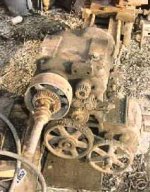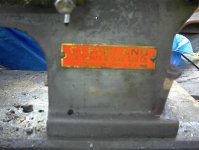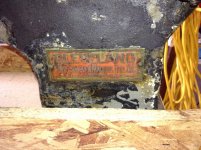Simplex appears to be on a dealer's tag, with the dealer being in Cleveland.
The design and shape of the headstock and bed suggest a lathe that was sometimes badged as "Rapid Precision" and sold in the USA. The "Rapid Precision" lathes are not too common, and the belief is they were built in Germany, pre WWII, for export. As a result, fasteners on the lathe parts will be in US thread sizes, and micrometer collars will be in inch measurements, and the quick change gearbox will cut "threads per inch".
The clues are that humped headstock around the sprindle bull gear, and the shape of some of the levers, as well as the design of the headstock spindle bearings. These are tapered bronze bearings, adjustable with threaded collars on the inside and outside of the headstock. The oil cups on the headstock feed into thin-walled brass or bronze tubing. This tubing serves not only to conduct the oil into the headstock bearings, but as locator/anti-rotation dowels for the bearings as well as for the headstock top cover. If you need to pull the bearings, you have to pull up those bronze oil tubes. When you lift the headstock top cover off, you will find the bronze tubes sticking up from the end walls. This is no mistake, those projecting pieces of the bearing oil tubes are there for a purpose.
The "rapid Precision" lathes used that ball-end handlever to shift the high/low spindle speed gearing (a set of jaw or dog clutches). My own Rapid Precision lathe had the same lever, same exact design, same location and same humped headstock.
The "Rapid Precision" lathes were built by a German manufacturer, but were not up to the standards of higher end German machine tools. I once owned a "Rapid Precision" lathe, about 10" swing, with loose change gears- back in about 1968 or so. At the time there was no internet, and no one had ever heard of a "Rapid Precision" lathe. The only place the name appeared was on the change gear data plate. The lathe was sold around 1986, so is long gone. Years later, with the arrival of the internet and this 'board, some other person posted about owning a "Rapid Precision" lathe and posted photos. His lathe had the quick change gearbox, but was otherwise very much like the 10" Rapid Precision lathe I had once owned. In the discussion of the Rapid Precision lathes, the strong belief was these were German built machines, built for export and re-sale. Since these machines were being built to a price point, and being built for re-sale by a variety of companies or dealers, no maker's name was incorporated into the castings. This allowed the marketer of the lathes to affix his own nameplate.
Look on Tony Griffith's Lathe Archive at some of the pre-war German lathes and you will see some strong resemblances. At this point, I'd say you have an exceedingly rare lathe, and I do not think you will find much further information. I do remember that the spindle nose thread on my 10" Rapid Precision lathe corresponded to the spindle nose thread on a 10" Southbend lathe (if my memory serves me correctly).







 . It was a forlorn hope, I guess. He and one other (I think) are the only ones who have ever posted pictures resembling my lathe (headstock, apron, tailstock castings).
. It was a forlorn hope, I guess. He and one other (I think) are the only ones who have ever posted pictures resembling my lathe (headstock, apron, tailstock castings).





 I did an initial go-through disassembly, refit, and repaint to ID problems and issues to corrected later.... I painted it hammertone black. Not even CLOSE to the original black.
I did an initial go-through disassembly, refit, and repaint to ID problems and issues to corrected later.... I painted it hammertone black. Not even CLOSE to the original black. )
)